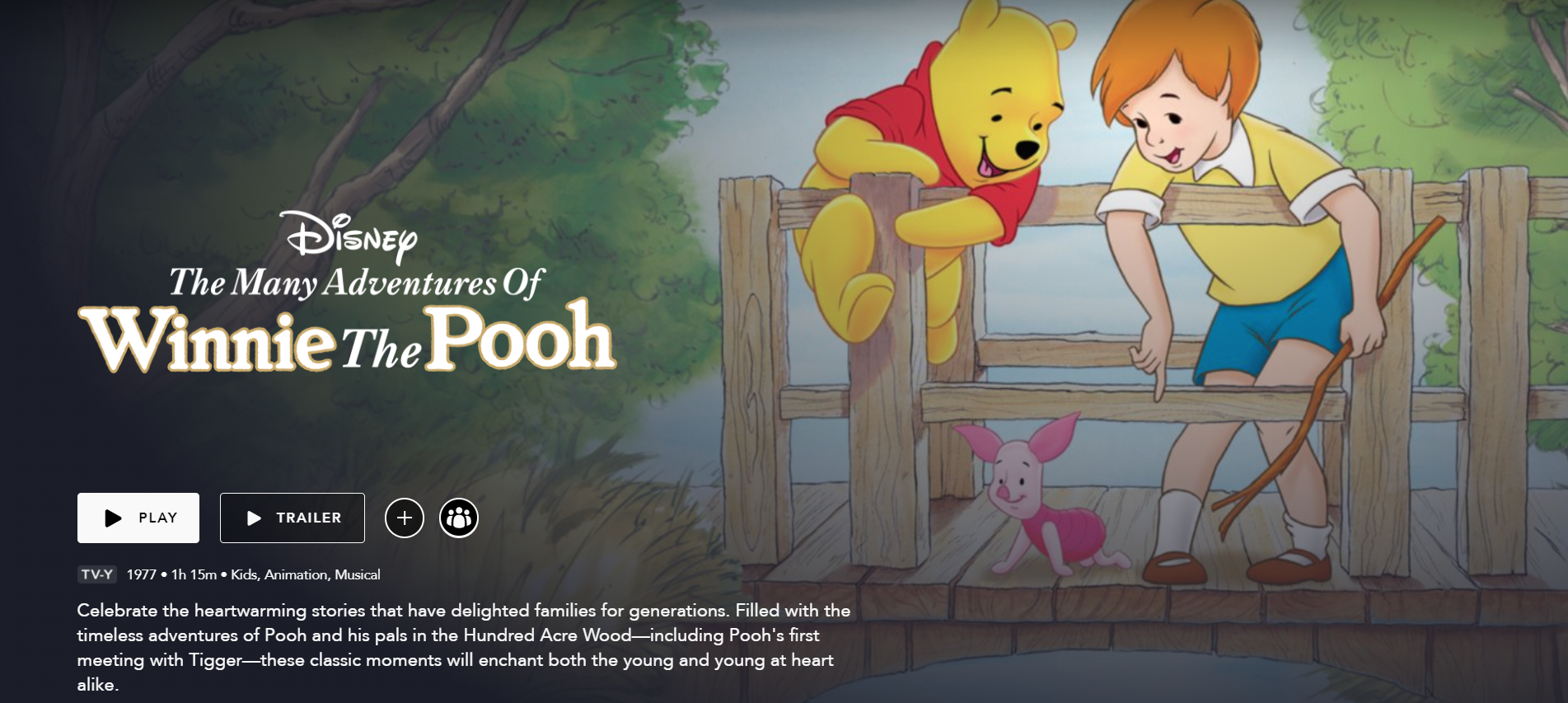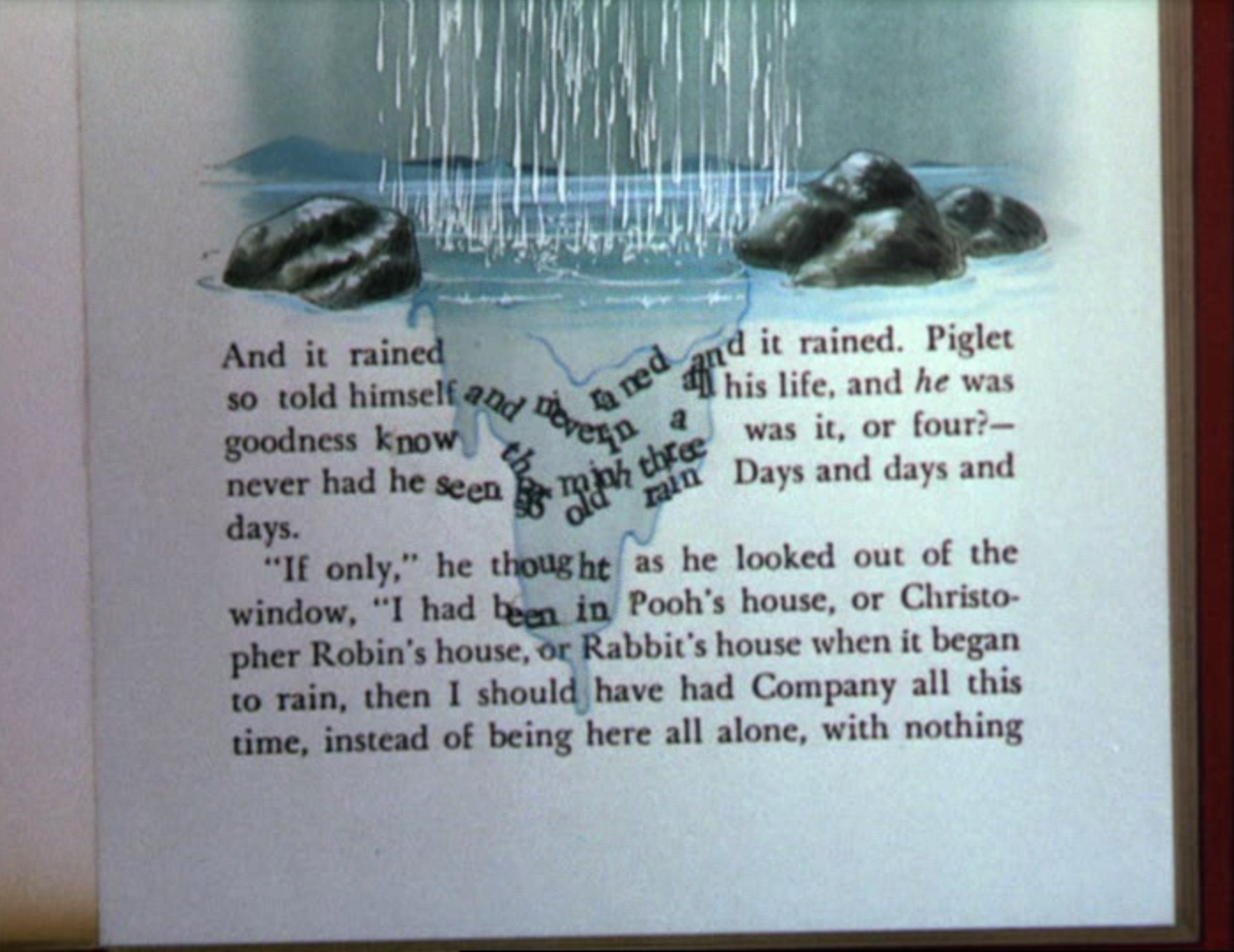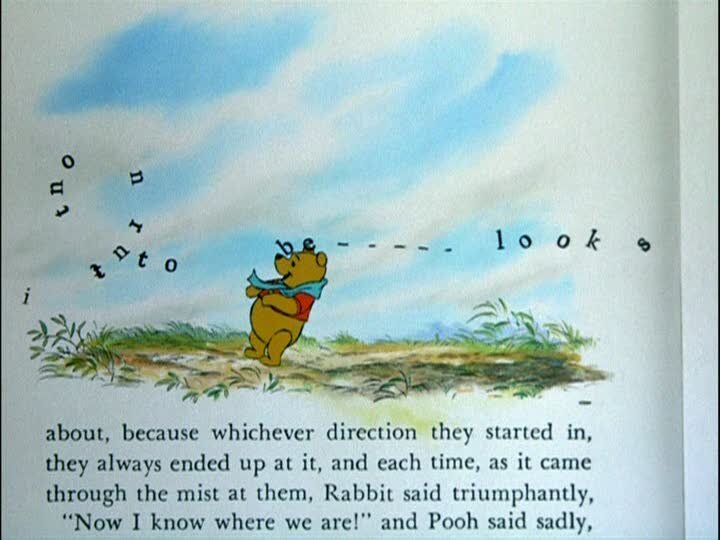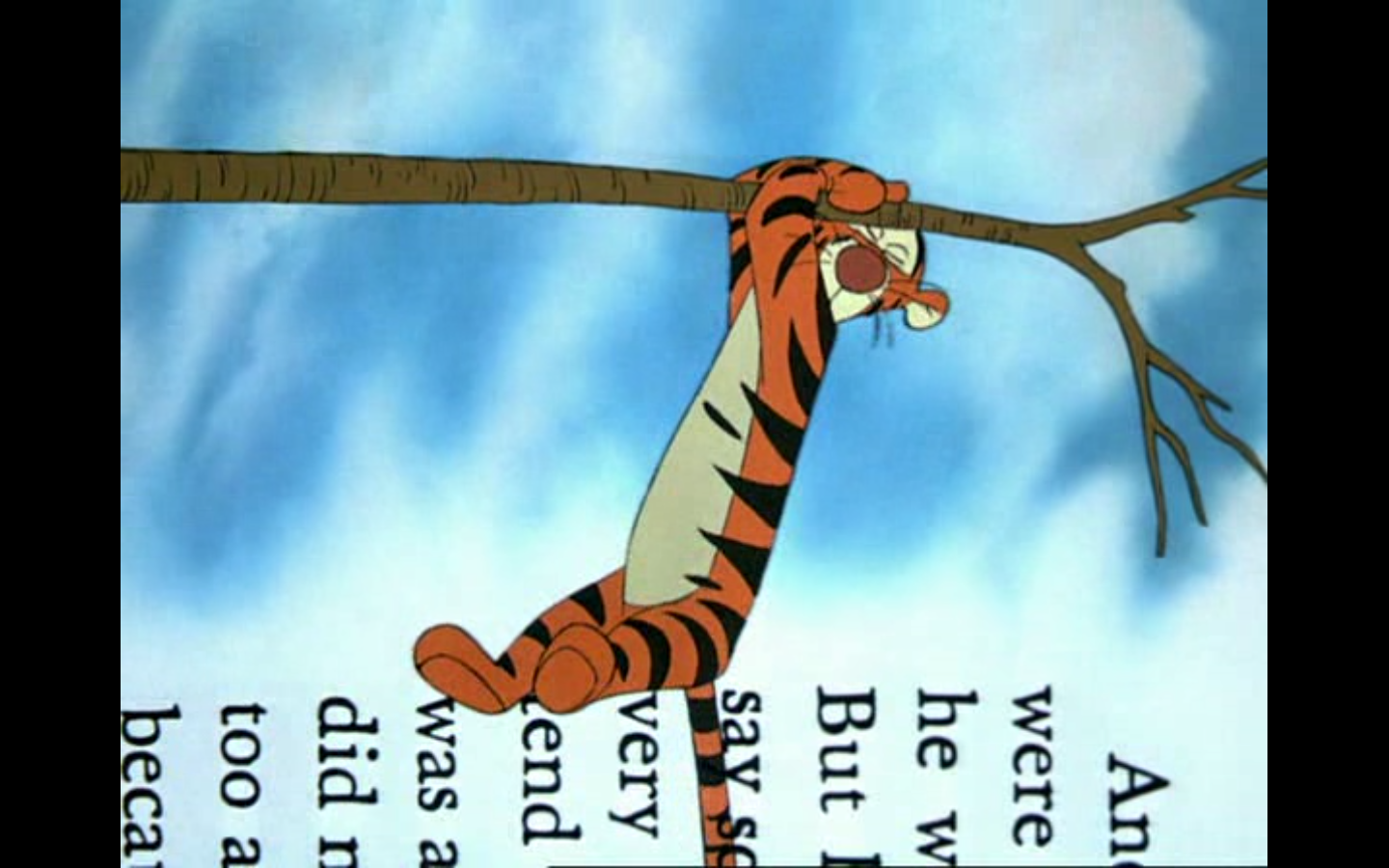Review: The Many Adventures of Winnie the Pooh (DMC #62)
“Hip, hip, Pooh-ray for Winnie the Pooh! (And Piglet, too!)” Last night we watched The Many Adventures of Winnie the Pooh, the first of many more adorable Winnie the Pooh animated films, and the sixty-second film in our Disnerd Movie Challenge! In case you’ve never seen this one before, we’ve included our synopsis below. If you have seen it before, skip ahead to our review!
Synopsis
Deep in the Hundred Acre Wood, a bear called Winnie the Pooh begins his morning by doing his stoutness exercises to work up an appetite. But when Pooh discovers that his honey pot is empty, he goes off in search of honey. He follows a bee to a honey tree and attempts to climb the tree, but he falls. Pooh’s best friend, a boy named Christopher Robin, is reattaching the tail of Eeyore (a donkey) while Owl (the owl), Kanga (a kangaroo), and Roo (Kanga’s son) supervise. Pooh arrives and asks if he can borrow a balloon from Christopher Robin so he can use it to fly up to the honey tree. Christopher Robin agrees, and together he and Pooh use mud to disguise the bear as a little black raincloud so as to sneak past the bees. However, when Pooh goes to snack on some of the bees’ honey, he accidentally eats a few bees. He spits the bees out, but not before angering them. The bees chase after him until he and Christopher Robin dive into a muddy puddle to escape. Still determined to find some honey, Pooh visits Rabbit’s house. Despite Rabbit’s efforts to pretend he’s not home, Pooh invites himself in and helps himself to all of Rabbit’s honey. But when Pooh tries to leave Rabbit’s burrow, he gets stuck because he ate too much. Rabbit goes out the other door and fetches Christopher Robin to help, but it is no use. Pooh is stuck, and they’ll just have to wait for him to get thin again. After several days of Rabbit trying to make Pooh’s backside something presentable to look at and running interference so Gopher doesn’t feed Pooh anything more, Pooh finally budges! Rabbit runs to get the others, and the whole Hundred Acre Wood comes out to pull Pooh loose. They succeed, but Pooh goes flying from one page of the book to the next and lands face-first in the honey tree—much to Pooh’s delight!
In the next chapter, it’s a very blustery “Windsday” in the Hundred Acre Wood. Pooh visits his dear friend, Piglet, but Piglet is struggling against the wind. A rather large gust sends Piglet airborne. Pooh grabs hold of Piglet’s scarf, but the scarf unravels until Piglet is flying from one end of the string like a kite, pulling Pooh along on the ground below. The two finally come to a stop when they smack into the window of Owl’s treetop house. Owl happily welcomes them, but the wind soon blows down the entire tree, destroying Owl’s house. Christopher Robin and some of the other animals hurry over upon hearing of the disaster. Eeyore takes it upon himself to find a new home for Owl and sets off at once. That night, Pooh is at home when he hears a strange noise. It’s a tiger named Tigger who pounces on Pooh and happily introduces himself and his love of bouncing. After realizing he doesn’t like honey, Tigger tells Pooh that honey is only good for Heffalumps and Woozles, who are known to steal honey. After Tigger leaves, it starts to rain and Pooh has nightmares about Heffalumps and Woozles stealing his honey. When Pooh wakes up, his house is flooded from the storm. Meanwhile, Piglet’s house has flooded, too. Piglet hastily drafts note for help and places the message in a bottle as he floats on a chair out his front door and into the flood. Back at Pooh’s house, the water has risen significantly. As Pooh tries to lick the last bit of honey from a pot, he falls from his treetop perch and lands in the water with his head still inside the now-floating honey pot. Christopher Robin’s house hasn’t flooded, so everyone else makes their way to his house (except Eeyore, who’s still on the search for a home for Owl). While at Christopher Robin’s, Roo finds Piglet’s note and Christopher Robin sends Owl to go look for Piglet. Owl finds Piglet and Pooh floating near each other, though he does nothing as Piglet and Pooh go over a waterfall and then float over to Christopher Robin’s house, with Pooh now sitting on Piglet’s chair and Piglet inside Pooh’s honey pot. Christopher Robin credits Winnie the Pooh with rescuing Piglet and arranges a hero party to honor Pooh, but Eeyore interrupts the party to say he’s found a home for Owl. He leads everyone to…Piglet’s house. Despite everyone else’s unease at the awkwardness of it, Piglet tearfully says Owl should have his house. Pooh insists that Piglet come live with him, and he asks Christopher Robin to make the hero party into a two hero party to celebrate Piglet’s heroic deed, too.
In the next chapter, Tigger bounces Pooh, then Piglet, and finally, Rabbit, who has had enough of Tigger’s bouncing. Rabbit arranges a protest meeting with Pooh and Piglet to find a way to stop Tigger from bouncing. Rabbit decides they should lose Tigger somewhere he’s never been before as a way to humble him. The next day, Rabbit, Pooh, and Piglet go into the misty woods with Tigger and try to lose him, but after ditching Tigger, the three of them end up lost themselves. No matter which way they go, they keep returning to the same pit. Pooh suggests they try to find the pit on purpose, but Rabbit thinks the idea is silly. To prove it, Rabbit marches off into the woods on his own, intending to find the pit again, except Rabbit gets lost. Pooh’s tummy rumbles and he decides he and Piglet will follow the sound of his honey pots to make their way home. Just as Pooh and Piglet leave the mist of the woods, Tigger bounces them. Their plan failed, because “Tiggers don’t get lost.” Tigger goes into the mist to find Rabbit. Back in the woods, Rabbit’s mind begins to play tricks on him, making every sound seem terrifying. When Tigger finally finds Rabbit, Rabbit is the one who’s been humbled by the endeavor.
It’s the first snowfall in the Hundred Acre Woods and Tigger takes Roo out to play, promising Kanga to have Roo home in time for his nap. Tigger takes Roo to the frozen lake where Rabbit is ice skating. Roo asks if Tigger can ice skate, and Tigger overconfidently tells Roo that of course he can ice skate. However, when Tigger sets out to prove it, he ends up colliding with Rabbit, sending Rabbit hurtling into his own home. As Roo and Tigger continue on, Roo suggests they climb trees. Tigger again becomes overconfident and insists Tiggers can climb trees, except that once he bounces his way to the top of the tree with Roo, Tigger looks down and realizes he’s terribly afraid of heights. Meanwhile, Pooh has been following a set of tracks in the snow when Piglet joins him. The two start following the tracks together, not realizing they’re following their own footprints in the snow. They start to suspect they’re following a rather formidable animal when they’re spooked by Tigger’s “Hallooooo,” thinking it’s a Jagular. Once they realize it’s Tigger and Roo stuck in the tree, they go to get help. Christopher Robin, Kanga, and Rabbit arrive and spread out Christopher Robin’s coat like a trampoline to catch Roo who happily leaps from the tree. Tigger, however, is too terrified to jump down. Rabbit is satisfied at the prospect of Tigger staying up in the tree forever. Tigger, in his terror, promises that if he ever gets down from the tree he will never bounce again. However, after the narrator turns the book to help slide Tigger safely down to the ground, Tigger is so overjoyed he begins to bounce—until Rabbit reminds him of his promise. Tigger becomes terribly sad, and all his friends start to say how they liked the old Tigger best. Eventually Rabbit caves, and he, too, admits he liked the old Tigger better. Tigger is allowed to bounce again, and he gets all his friends to bounce along with him to celebrate.
In the final chapter, Christopher Robin and Pooh go to the Enchanted Place. Christopher Robin will be going to school soon, but the animals don’t quite understand what school is. Christopher Robin tells Pooh how much he enjoys doing nothing with Pooh. He asks Pooh, “Promise you won’t forget me? Not even when I’m 100?” Pooh promises, and the two sit under their favorite tree together.
Thoughts Before Watching
Megan: Winnie the Pooh!!! After so many complete unknowns in our challenge, I’m so excited to return to one of the animated classics of my childhood! I remember watching this and so many other Winnie the Pooh films or cartoons as a kid, so I have a huge nostalgia factor going into this viewing. Let’s see if this film still holds up to what I enjoyed as a kid!
Kevin: If I were to rank every Disney animated character, Winnie the Pooh and his friends would probably be somewhere in the middle. When I was a kid, I probably watched the cartoons only a couple of times, but I preferred anything to do with Mickey Mouse, Donald Duck, or Goofy over Winnie the Pooh. I will say that I adore the songs “Rumbly in My Tumbly” and “Little Black Rain Cloud”; I will happily sing along to those any day. I haven’t seen this anthology film in years, so I’m wondering how much I’ll remember.
Thoughts After Watching
You can’t not like Winnie the Pooh!
Megan: I love Winnie the Pooh! I may be an adult now, but I still love how cute and adorable this movie is! Even with some of the more recent and rather questionable of Winnie the Pooh retellings (I’m looking at you Christopher Robin), it’s hard not to love this silly old bear. I love the childhood bedroom opener that shows the characters as stuffed animals in a nod to the original stuffed animals that inspired the books; I love the map of the Hundred Acre Wood with all the little kid spellings; I love the songs… Honestly, I don’t even mind that this film fails the Bechdel test. This is the world of a little boy’s imagination, after all, and just as I was a little girl who filled her imaginary world with mostly female characters, Christopher Robin is a little boy who fills his imaginary world with mostly male characters. Besides, the real heart of this story is the friendship between a little boy and his favorite stuffed bear, Winnie the Pooh.
So many familiar voices!
Kevin: This movie is chock full of veteran voice actors from past Disney movies! I think I had more fun identifying these actors than the story itself. I was able to point out many of the films these voice actors starred in, with only a couple that I needed to look up just to double check if I was correct (yeah, I’m bragging a bit here!). First up, of course, is the lovable bear himself, voiced by Sterling Holloway. Holloway’s voice is probably instantly memorable for anyone who has seen several of Disney’s earlier animated films. Some of his roles might be obvious while others are less so, but among Holloway’s many voice credits are also Mr. Stork in Dumbo, the adult skunk Flower in Bambi, the Cheshire Cat in Alice in Wonderland, Kaa in The Jungle Book, and Roquefort in The Aristocats. He was also the narrator in some animated shorts and sequences such as the penguin sequence in The Three Caballeros, the “Peter and the Wolf” sequence in Make Mine Music, and Lambert the Sheepish Lion. Considering all of these films and shorts came out years apart, spanning nearly 30 years, the fact that Holloway could keep his voice sounding like that is impressive! The Many Adventures of Winnie the Pooh includes other notable and recognizable voice actors. Piglet is voiced by John Fiedler, who, as Megan pointed out in our review of The Shaggy D.A., played animal control officer Howie Clemmings. Fiedler also did the voice of Father Sexton in Robin Hood, although he was uncredited. He continued voicing Piglet up until his death, and also voiced the old man Rudy in The Emperor’s New Groove (It all makes sense now. That voice is definitely the sound of an older Piglet!).
Kevin: Continuing on with the voices, Christopher Robin is voiced by at least three actors: Bruce Reitherman, known for voicing Mowgli in The Jungle Book; Jon Walmsley, who has since become an accomplished musician, and Timothy Turner. Roo is voiced by Dori Whitaker and Clint Howard (younger brother of Ron Howard), who also voiced Haithi Jr. in The Jungle Book. Roo’s mother, Kanga, was another I immediately recognized: Barbara Luddy voiced Lady in Lady and the Tramp, Merryweather from Sleeping Beauty, Rover in One Hundred and One Dalmatians, and both Mother Sexton and Mother Rabbit in Robin Hood (also uncredited, like Fiedler was). Rabbit is voiced by Junius Matthews, who also did the voice of Archimedes in The Sword in the Stone. The last voice I knew was that of Sebastian Cabot, the film’s narrator as well as the voice of Bagheera (who also opens the film as narrator) in The Jungle Book.
The only characters whose voices I didn’t know were Eeyore, Tigger, Owl, and Gopher, played by Ralph Wright, Paul Winchell, Hal Smith, and Howard Morris, respectively. In the case of Paul Winchell, he also had the unfortunate role of Shun Gon, the racially insensitive Siamese cat in The Aristocats, but he still had many characters on his resume. Smith and Morris were also accomplished voice actors with extensive credits, and Wright’s primary career was actually as an animator and storyboard artist for Disney. One of the coolest things I learned about him was that he and several of his contemporaries pioneered the concept of “How To” cartoons that usually featured the main character’s failed attempts at achieving their goals. This practice remains in use at many animation studios to this day, with Warner Bros. making heavy use of the premise in their cartoons starring Wile E. Coyote and the Road Runner, Sylvester and Tweety, and Bugs Bunny and Daffy Duck.
I’m a fan of the book motif
Megan: Something I’ve always loved about this particular Winnie the Pooh movie is the book motif that is carried throughout the film. While previous Disney animated movies included a similar storybook opener with a realistic book opening to an animated world, none of those other films maintained the motif beyond the beginning and ending of the movie. The Many Adventures of Winnie the Pooh, on the other hand, very playfully continues this motif throughout the story. We see Pooh walk or fly from one page to the next, with Gopher even shouting at one point “Quick! Turn the page!” so Pooh doesn’t fly clear out of the book. We see the words on the pages blown off by the wind, or washed away by the rain. Then, of course, there’s the great inside joke about Gopher: “After all, he’s not in the book, you know.” (Gopher was not one of the original Winnie the Pooh characters created by A.A. Milne, but rather a character created by Disney and introduced in this movie). One of my favorite scenes is when Tigger, having nearly bounced out of the book in climbing to the top of the tree, is helped out of the tree by the narrator rotating the book so that Tigger can slide down along the text of the page. This is one of the few films I can think of where the narrator really becomes a part of the story, and that is largely thanks to the book motif that carries throughout the film and allows the characters to break the fourth wall to speak directly with the narrator. It also serves as a great connector between each little story about Pooh and his friends. Without the book motif, I don’t know that the stories would feel nearly as connected as they do.
Rabbit is more relatable, but still a buzzkill
Kevin: If you asked me who my least favorite character from Winnie the Pooh cartoons would have been when I was a kid, I would have easily said Rabbit. He was a killjoy and had a weird sense of entitlement and superiority. As I’ve gotten older, I suppose I’ve come to empathize a bit more with Rabbit—not the sense of entitlement or superiority, but more so his general outlook and personality. Rabbit is possibly the most responsible of the characters, although perhaps even that can be debated. Still, it’s clear that Rabbit’s “killjoy” mentality is just because he wants some peace and quiet in his life. He’s surrounded by more wacky and eccentric characters, all of whom get into all sorts of trouble, and all Rabbit desires is to live his life without said characters mucking it up. He’s basically the early version of characters like Squidward from SpongeBob SquarePants. The biggest difference, though, is that Rabbit does care about his friends and will absolutely help them when truly needed, whereas Squidward just hates everyone and everything in his life. Children do not generally identify with characters like Rabbit (or Squidward), and would instead be more likely to relate to the more child-like characters. Unfortunately, after growing up a bit and experiencing some of the pangs of adult life, you can start to appreciate what someone like Rabbit wants. I mean, the fact that Pooh just casually invites himself over to Rabbit’s burrow and eats all his honey? That’s a BIG no-no, and I was honestly surprised Rabbit didn’t protest harder. Sometimes, all someone wants is to be left alone and not be surrounded by silly things. It’s perfectly natural. That said, Rabbit is definitely still a buzzkill, especially when he attempts to make Tigger stop bouncing. Tigger could certainly tone down the bouncing a bit, if only so that he doesn’t accidentally hurt anyone, but Rabbit initially tries to get Tigger to stop bouncing entirely. This is obviously not the best thing to do because bouncing is one of Tigger’s primary loves and traits; it’s basically his identity. Although Rabbit may not realize it (and the film doesn’t really go this far to address it), asking Tigger to give up bouncing is tantamount to denying Tigger’s sense of identity. It’s a bad move on Rabbit’s part, so while we might relate to him more, he cannot be completely absolved. Thankfully, Rabbit ultimately realizes there is value in Tigger being who he is, and admits that he prefers Tigger bouncing. Wow… I did not actually expect to come away from this movie thinking about identity like that. But, hey! This goes to show that a film that doesn’t really hold the same nostalgia for me as it does others still has some hidden gems within it!
The many archetypes of the Hundred Acre Wood
Megan: Part of what makes the characters of the Hundred Acre Wood so relatable is how each of them seems to embody a particular human emotional state. This was something I’d easily picked up on as a kid, but it wasn’t until I listened to the Winnie the Pooh meditation series on the Calm app that I realized just how profound this is. (If you want to listen to the meditation series, the first 5 people to click this link can get a 30-day free trial of the Calm app!) The meditations draw from a series of books by Benjamin Hoff, the first of which is The Tao of Pooh, and they go on to talk about how each of the characters from Winnie the Pooh embodies a particular emotion or way of being. Winnie the Pooh, for example, embodies the Chinese concept of "wu wei” which means “inexertion,” “inaction,” or “effortless action.” According to Wikipedia, wu wei also describes “a state of unconflicting personal harmony, free-flowing spontaneity, and savoir-faire.” This is who Pooh Bear is. He is largely untroubled by the world around him. He enjoys doing nothing (especially when he’s doing nothing with Christopher Robin), and with how often he visits his Thinking Spot, you might say Pooh is perhaps the most meditative character. Piglet, of course, is the embodiment of worry. He’s forever anxious, though not entirely without good reason seeing as how his small stature makes a blustery day or a sudden flood far more dangerous. I think Piglet is a great character for kids to identify with, since they, too, are “rather small animals” who sometimes get scared, but have the capacity to be very brave. Kevin already hinted at this, but Tigger, as the meditation series explains, is the embodiment of authenticity. Think about it—Tigger can’t help but be his true, bouncy self, boldly declaring to everyone “I’m the only one!” Of course, he can be overconfident, too, and that gets him into trouble when he realizes too late that he’s terrified of heights. His flaw is that of failing to think before he quite literally leaps. Eeyore, as you can probably guess, embodies pessimism. He’s a rather depressive character with his gloomy disposition, and it’s hard for him to look on the bright side, yet his friends are still there by his side no matter what. I think that’s important for children to see—that it’s okay to feel sad or gloomy sometimes, and that true friends will stick by you even when you have bad days. The last one the meditation series examines is Rabbit, who embodies busyness. If you think back at these short vignettes in The Many Adventures of Winnie the Pooh, Rabbit is always doing something. Often he’s gardening, but even when Pooh gets stuck in Rabbit’s house, Rabbit can’t sit still with the situation. He turns Pooh’s backside into his next project, trying various ways to beautify an otherwise unsightly situation. I think a lot of us as adults can relate to Rabbit, and I’m pretty sure many children see their parents in Rabbit. Rabbit is the rule enforcer, the kill-joy, the strict one, but he’s also the responsible one who quite reasonably dislikes being inconvenienced, and he’s quick to find solutions to recurring problems. Though he might not be a favorite, the characters of the Hundred Acre Wood do need Rabbit’s help sometimes. And though Rabbit would be the last to admit it, he needs the help of the other characters to balance him out and remind him to relax every once in a while. Together, all the characters of the Hundred Acre Wood serve not only as great examples to help children talk about their emotions, their archetypal nature gives the characters, and their story, great staying power so that adults and children alike can enjoy the stories many years after this film was created.








